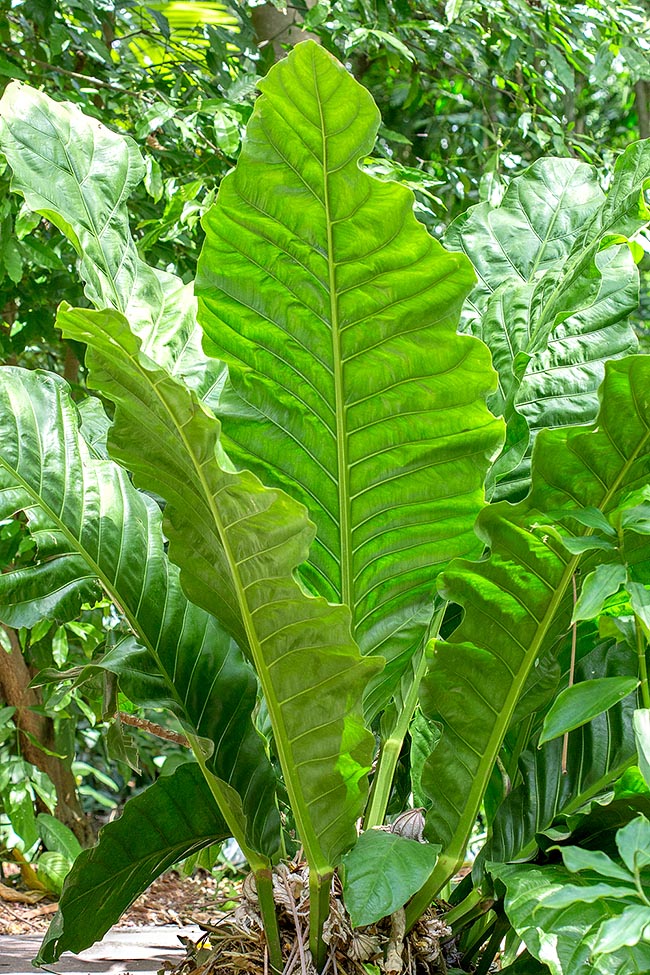Family : Araceae

Text © Pietro Puccio

English translation by Mario Beltramini
The species is native to Belize, Guatemala, Honduras, Mexico (Campeche, Chiapas, Jalisco, Mexico, Oaxaca, Quintana Roo, Tabasco, Veracruz and Yucatán) and Nicaragua where it grows epiphyte on the trees of the rainforests or on calcareous emerging rocks covered by vegetal residues, from the sea level up to about 1500 m of altitude.
The generic name is the combination of the Greek substantives “ἄνθος” (ánthos) = flower and “οὐρά” (ourá) = tail, with reference to the spadix of the inflorescence; the species is honored to the German botanist Diederich Franz Leonhard von Schlechtendal (1794-1866).
Common names: bird’s nest anthurium, pheasant’s tail (English); boobtúum, kilbal chak, pool boox, u-k’uts-box (Maya); xiv ak tun ich (Mopan); tye i pù (Q’eqchi’); cola de faisán, hoja de cuero, hoja de viento, lengua de ciervo, raíz de piedra (Spanish).
The Anthurium schlechtendalii Kunth (1841) is a very variable evergreen herbaceous species, usually epiphyte, less frequently lithophyte or terrestrial, with short stem, of 3-5 cm of diameter, with close internodes from which develop numerous white-greenish fleshy roots, in part bent upwards, that facilitate the accumulation of vegetal debris contributing to the nourishment of the plant. The leaves, on a 8-20 cm long robust petiole, are erect, simple, obovate-elliptic with wavy margin and obtuse to acuminate apex, coriaceous, semi-glossy, of dark green colour, 0,4-1,5 m long and 10-50 cm broad, with prominent central and lateral veins of pale green colour. Axillar inflorescences, on a 35-50 cm long peduncle, of 0,6-1 cm of diameter, formed by a persistent linear lanceolate spathe with acuminate apex, 8-25 cm long and 1,5-5 cm broad, of green colour suffused of violet purple, retroflexed, and by a sessile spadix, 7-60 cm long, and of about 2 cm of diameter slightly decreasing towards the obtuse apex.

The Anthurium schlechtendalii is an evergreen herbaceous epiphyte, also terrestrial, of Central America. In the tropics is cultivated due to the spectacular leaves reaching 150 cm with prominent veins and medicinal virtues © Giuseppe Mazza
Tiny square flowers, of about 2 mm of side, spirally arranged, perfect, but only those arranged in the lower part are functionally hermaphrodite and protogynous (the stigma, the female part, is receptive before the ripening of the stamens, this prevents the autogamy) and produce fruits.
Infructescences with curved spadix, about 60 cm long and of 5 cm of diameter, and oblong berries, 1 to 2 cm long, of bright red colour, containing two oblong-elliptic seeds, 0,5-0,6 cm long, immersed in an irritant whitish pulp due to the presence of crystals of calcium oxalate.
The Anthurium schlechtendalii is usually reproduces by seed placed superficially in porous soil, draining, rich of organic substance, maintained humid at the temperature of 26-28 °C.
Amply cultivated thanks to the large ornamental leaves in the gardens of the tropical, subtropical and marginally warm temperate climate regions, where it can resist exceptional drops of temperature little lower of 0 °C, with possible damage to the foliage.
It grows in filtered sunlight as well as in shade, in position sheltered against the strong winds, on draining soils rich of humus kept almost constantly humid, even if when adult may bear short periods of dryness.
It adapts well to the cultivation in pot for the decoration of spacious and luminous locations in porous organic and perfectly draining soil.
This species need a frequent watering, but without stagnations, in summer, more spaced in winter in way to allow the substratum to partially dry up before watering again.
The leaves are utilized since remote times in the traditional medicine mainly as analgesic and antiedemic in the cramps, muscular pains, rheumatisms and paralyses.
Two subspecies are recognized:
– Anthurium schlechtendalii subsp. schlechtendalii
The aforementioned.
Synonyms: Pothos schlechtendalii (Kunth) M.Martens & Galeotti (1843); Anthurium mexicanum Liebm. (1849); Anthurium kunthianum Liebm. (1854); Anthurium brachygonatum Schott (1860); Anthurium hookeri Schott (1860); Anthurium tetragonum Hook. ex Schott (1860); Anthurium fortinense Engl. (1898); Anthurium tetragonum var. yucatanense Engl. (1905); Anthurium tikalense Lundell (1966).
– Anthurium schlechtendalii subsp. jimenezii (Matuda) Croat (1984).
Terrestrial or lithophyte growing in the seasonal dry forests of the Pacific side of Mexico (Guerrero and Oaxaca) and distinguishes for the more reduced size and the spathe usually ovate and erect instead of retroflexed.
Synonym: Anthurium jimenezii Matuda (1962).
→ To appreciate the biodiversity within the ARACEAE family, please click here.
